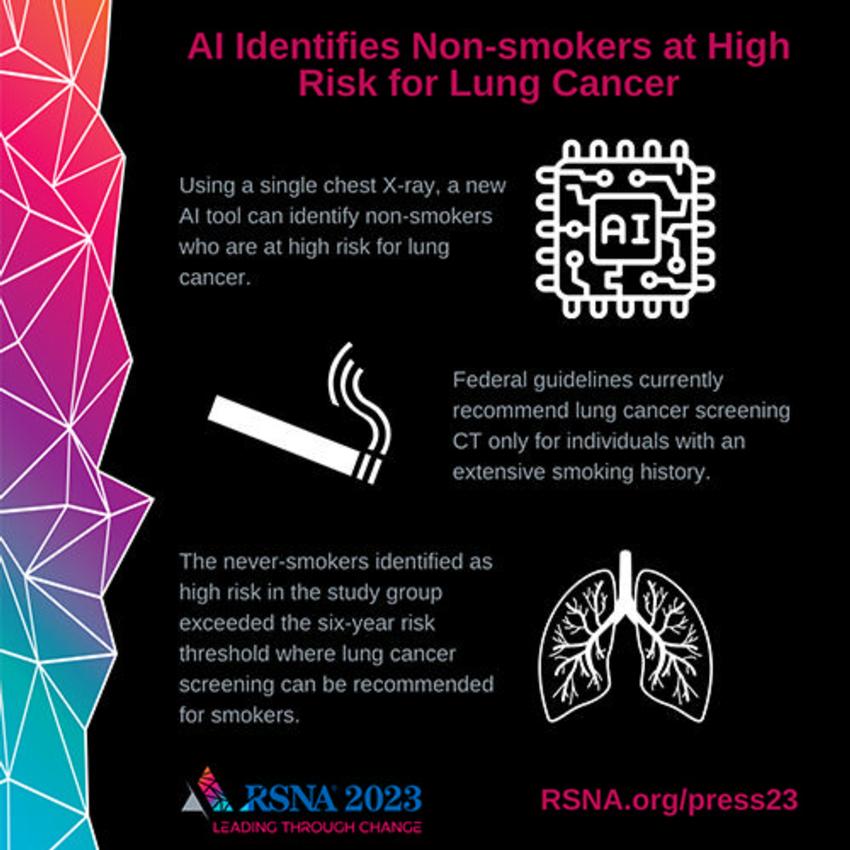In a groundbreaking study set to be presented at the upcoming annual meeting of the Radiological Society of North America (RSNA), researchers reveal how artificial intelligence (AI) can leverage routine chest X-ray images to identify non-smokers at high risk for lung cancer. This discovery could revolutionize early detection strategies, particularly for a segment of the population currently excluded from conventional screening guidelines.
The Burden of Lung Cancer:
Lung cancer stands as the leading cause of cancer-related deaths globally, with a particularly high toll in the United States. The American Cancer Society estimates a staggering 238,340 new cases and 127,070 deaths from lung cancer this year alone. Notably, 10-20% of lung cancers manifest in “never-smokers,” individuals who have either never smoked or smoked fewer than 100 cigarettes in their lifetime.
Current Screening Guidelines:
The United States Preventive Services Task Force (USPSTF) recommends low-dose CT screening for lung cancer in adults aged 50 to 80 with a significant smoking history. However, this recommendation excludes those who have never smoked or smoked minimally, despite a rising incidence of lung cancer in this population. Consequently, when discovered, lung cancers in never-smokers tend to be diagnosed at later, more advanced stages.
The Study’s Lead Author’s Insights:
Anika S. Walia, the lead author of the study and a medical student at Boston University School of Medicine, emphasizes the limitations of current screening guidelines. Walia notes that while federal guidelines primarily target individuals with substantial smoking histories, the prevalence of lung cancer in never-smokers, often diagnosed at an advanced stage, calls for a paradigm shift in screening approaches.
Addressing Prediction Challenges:
The study addresses the challenge of predicting lung cancer risk in never-smokers, a group for which existing risk scores often lack essential information. Traditional risk scores typically require data such as family history of lung cancer, pulmonary function testing, or serum biomarkers, information not readily available for most individuals.
The CXR-Lung-Risk Model:
To overcome these limitations, researchers at the Cardiovascular Imaging Research Center (CIRC) developed the “CXR-Lung-Risk” model. This deep learning model was trained using 147,497 chest X-rays from both smokers and never-smokers to predict lung-related mortality risk based on a single chest X-ray image. The model demonstrated its efficacy in identifying high-risk individuals among never-smokers.
Study Findings and Validation:
The model was externally validated in a separate group of never-smokers undergoing routine outpatient chest X-rays. Of the 17,407 patients included in the study, 28% were identified as high risk by the AI tool, with 2.9% of these individuals later receiving a lung cancer diagnosis. Even after adjusting for various factors, the high-risk group exhibited a 2.1 times greater risk of developing lung cancer compared to the low-risk group.
Implications and Future Prospects:
The study’s senior author, Dr. Michael T. Lu, underscores the potential of this AI tool in enabling opportunistic screening for never-smokers at high risk of lung cancer, utilizing existing chest X-rays in electronic medical records. As smoking rates decline, the significance of early detection strategies for non-smokers becomes increasingly pronounced.
This groundbreaking study not only challenges existing screening norms but also highlights the transformative potential of artificial intelligence in identifying high-risk individuals for lung cancer among never-smokers. The integration of AI tools into routine medical practices, utilizing widely available chest X-rays, could mark a pivotal shift in the early detection and management of lung cancer, ultimately saving lives in a population often overlooked by traditional screening guidelines.


